Aston Villa F.C.
Aston Villa Football Club is an English professional football club based in Aston, Birmingham. The club competes in the Premier League, the top tier of the English football league system. Founded in 1874, they have played at their home ground, Villa Park, since 1897. Aston Villa were one of the founder members of the Football League in 1888 and of the Premier League in 1992.[5] Villa are one of only five English clubs to have won the European Cup, in 1981–82. They have also won the Football League First Division seven times, the FA Cup seven times, the League Cup five times, and the European (UEFA) Super Cup once.
.svg.png) | ||
| Full name | Aston Villa Football Club | |
|---|---|---|
| Nickname(s) | The Villa The Lions The Claret & Blue Army | |
| Short name | Villa, AVFC | |
| Founded | 21 November 1874[1] | |
| Ground | Villa Park | |
| Capacity | 42,095[2] | |
| Owner(s) | Nassef Sawiris Wes Edens | |
| Chairman | Nassef Sawiris[3] | |
| Head Coach | Dean Smith[4] | |
| League | Premier League | |
| 2019–20 | Premier League, 17th of 20 | |
| Website | Club website | |
|
| ||
Villa have a fierce local rivalry with Birmingham City and the Second City derby between the teams has been played since 1879.[6] The club's traditional kit colours are claret shirts with sky blue sleeves, white shorts and sky blue socks. Their traditional club badge is of a rampant lion.[7][8] The club is currently owned by the NSWE group, a company owned by the Egyptian billionaire Nassef Sawiris and the American billionaire Wes Edens.
History
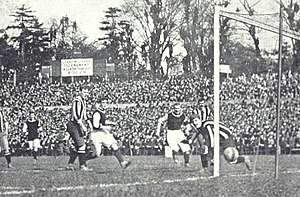
Formation and the Football League (1874−1920)
Aston Villa Football Club were formed in March 1874, by members of the Villa Cross Wesleyan Chapel in Handsworth which is now part of Birmingham. The four founders of Aston Villa were Jack Hughes, Frederick Matthews, Walter Price and William Scattergood.[9] Aston Villa's first match was against the local Aston Brook St Mary's Rugby team. As a condition of the match, the Villa side had to agree to play the first half under Rugby rules and the second half under Association rules.[10] After moving to the Wellington Road ground in 1876, Villa soon established themselves as one of the best teams in the Midlands, winning their first honour, the Birmingham Senior Cup in 1880, under the captaincy of Scotsman George Ramsay.[11]
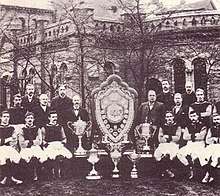
The club won their first FA Cup in 1887 with captain Archie Hunter becoming one of the game's first household names. Aston Villa were one of the dozen teams that competed in the inaugural Football League in 1888 with one of the club's directors, William McGregor being the league's founder. Aston Villa emerged as the most successful English club of the Victorian era, winning no fewer than five League titles and three FA Cups by the end of Queen Victoria's reign in 1901.[12] In 1897, the year Villa won The Double, they moved into their present home, the Aston Lower Grounds.[13] Supporters coined the name "Villa Park"; no official declaration listed the ground as Villa Park.[14]
Ups and downs (1920–1964)
Aston Villa won their sixth FA Cup in 1920, soon after though the club began a slow decline that led to Villa, at the time one of the most famous and successful clubs in world football, being relegated in 1936 for the first time to the Second Division. This was largely the result of a dismal defensive record: they conceded 110 goals in 42 games, 7 of them coming from Arsenal's Ted Drake in an infamous 1–7 defeat at Villa Park.[15] Like all English clubs, Villa lost seven seasons to the Second World War, and that conflict brought several careers to a premature end.[16] The team was rebuilt under the guidance of former player Alex Massie for the remainder of the 1940s. Aston Villa's first trophy for 37 years came in the 1956–57 season when another former Villa player, Eric Houghton led the club to a then record seventh FA Cup Final win, defeating the 'Busby Babes' of Manchester United in the final.[17] The team struggled in the league though and were relegated two seasons later, due in large part to complacency. However, under the stewardship of manager Joe Mercer Villa returned to the top-flight in 1960 as Second Division Champions. The following season Aston Villa became the first team to win the Football League Cup.[18]
Relegations and revival in the 80s (1964–1992)
Mercer's forced retirement from the club in 1964 signalled a period of deep turmoil. The most successful club in England was struggling to keep pace with changes in the modern game, with Villa being relegated for the third time, under manager Dick Taylor in 1967. The following season the fans called for the board to resign as Villa finished 16th in the Second Division. With mounting debts and Villa lying at the bottom of Division Two, the board sacked Tommy Cummings (the manager brought in to replace Taylor), and within weeks the entire board resigned under overwhelming pressure from fans.[19] After much speculation, control of the club was bought by London financier Pat Matthews, who also brought in Doug Ellis as chairman.[19] However, new ownership could not prevent Villa being relegated to the Third Division for the first time at the end of the 1969–70 season. However, Villa gradually began to recover under the management of former club captain Vic Crowe. In the 1971–72 season they returned to the Second Division as Champions with a record 70 points.[20] In 1974, Ron Saunders was appointed manager. His brand of no-nonsense man-management proved effective, with the club winning the League Cup the following season and, at the end of season 1974–75, he had taken them back into the First Division and into Europe.[21]

Villa were back among the elite as Saunders continued to mould a winning team. This culminated in a seventh top-flight league title in 1980–81. To the surprise of commentators and fans, Saunders quit halfway through the 1981–82 season, after falling out with the chairman, with Villa in the quarter final of the European Cup. He was replaced by his softly-spoken assistant manager Tony Barton who guided the club to a 1–0 victory over Bayern Munich in the European Cup final in Rotterdam courtesy of a Peter Withe goal. The following season Villa were crowned European Super Cup winners, beating Barcelona 3–1 on aggregate. This marked a pinnacle though and Villa's fortunes declined sharply for most of the 1980s, culminating in relegation in 1987.[22] This was followed by promotion the following year under Graham Taylor and a runners-up position in the First Division in the 1989–90 season.[23]
24 years in the Premier League (1992–2016)
Villa were one of the founding members of the Premier League in 1992, and finished runners-up to Manchester United in the inaugural season. For the rest of the Nineties however Villa went through three different managers and their league positions were inconsistent, although they did win two League Cups and regularly achieved UEFA Cup qualification. Villa reached the FA Cup final in 2000 but lost 1–0 to Chelsea in the last game to be played at the old Wembley Stadium.[24][25] Again Villa's league position continued to fluctuate under several different managers and things came to a head in the summer of 2006 when David O'Leary left in acrimony.[26] After 23 years as chairman and single biggest shareholder (approximately 38%), Doug Ellis finally decided to sell his stake in Aston Villa due to ill-health. After much speculation it was announced the club was to be bought by American businessman Randy Lerner, owner of NFL franchise the Cleveland Browns.[27]
The arrival of a new owner in Lerner and of manager Martin O'Neill marked the start of a new period of optimism at Villa Park and sweeping changes occurred throughout the club including a new badge, a new kit sponsor and team changes in the summer of 2007.[28][29] The first Cup final of the Lerner era came in 2010 when Villa were beaten 2–1 in the League Cup Final.[30] Villa made a second trip to Wembley in that season losing 3–0 to Chelsea in the FA Cup semifinal. Just five days before the opening day of the 2010–11 season, O'Neill resigned as manager,[31] and after one year with Gérard Houllier in charge, Birmingham City manager Alex McLeish, despite numerous protests from fans against his appointment; this was the first time that a manager had moved directly between the two rivals.[32] McLeish's contract was terminated at the end of the 2011–12 season after Villa finished in 16th place,[33] and he was replaced by Paul Lambert.[34] In February 2012, the club announced a financial loss of £53.9 million,[35] and Lerner put the club up for sale three months later, with an estimated value of £200 million.[36] With Lerner still on board, in the 2014–15 season Aston Villa scored just 12 goals in 25 league games, the lowest in Premier League history, and Lambert was sacked in February 2015.[37] Tim Sherwood succeeded him,[38] and steered the club away from relegation while also leading them to the 2015 FA Cup Final, but he was sacked in the 2015–16 season,[39] as was his successor Rémi Garde, but he could not prevent the club being relegated at the end of the season - ending their 29-year stay in the top flight.[40]
Takeovers, Championship years and promotion (2016–)
In June 2016, Chinese businessman Tony Xia bought the club for £76 million.[41] Former Chelsea boss Roberto Di Matteo was appointed as the club's new manager, but was sacked after a poor start to the season.[42] He was replaced by former Birmingham manager Steve Bruce.[43] Bruce led the team to finish 4th in the 17/18 season, but lost in the 2018 EFL Championship play-off Final to Fulham. In October 2018, Bruce was sacked after winning only once in a nine match stretch.[44]
He was replaced by Brentford manager Dean Smith, with John Terry and Richard O'Kelly as his assistants.[45][46] Under Smith performances and results improved, with the team finishing 5th and reaching the playoffs again—helped on by a club-record 10 league game winning streak. They reached the 2019 EFL Championship play-off Final and defeated Derby County 2–1 to gain promotion back to the Premier League after a 3-year absence.[47]
On 9 August 2019, on the eve of Villa's Premier League return, documents from Companies House revealed that Recon Group's minority share ownership had been bought out, and Xia no longer had any stake in the club.[48] In Villa's first season back in the Premier League the team battled relegation for most of the season but managed to avoid relegation with a 17th place finish, staying up on the final day.[49]
Colours and badge
| Wikimedia Commons has media related to Aston Villa F.C. kits. |
The club colours are a claret shirt with sky blue sleeves, white shorts with claret and blue trim, and sky blue socks with claret and white trim. They were the original wearers of the claret and blue. Villa's colours at the outset generally comprised plain shirts (white, grey or a shade of blue), with either white or black shorts. For a few years after that (1877–79) the team wore several different kits from all white, blue and black, red and blue to plain green. By 1880, black jerseys with a red lion embroidered on the chest were introduced by William McGregor. This remained the first choice strip for six years. On Monday, 8 November 1886, an entry in the club's official minute book states:
(i) Proposed and seconded that the colours be chocolate and sky blue shirts and that we order two dozen. (ii) Proposed and seconded that Mr McGregor be requested to supply them at the lowest quotation.
.svg.png)
The chocolate colour later became claret.[50] Nobody is quite sure why claret and blue became the club's adopted colours.[50] Several other English football teams adopted their colours; clubs that wear claret and blue include West Ham United and Burnley.[51][52]
A new badge was revealed in May 2007, for the 2007–08 season and beyond. The new badge includes a star to represent the European Cup win in 1982, and has a light blue background behind Villa's 'lion rampant'. The traditional motto "Prepared" remains in the badge, and the name Aston Villa has been shortened to AVFC, FC having been omitted from the previous badge. The lion is now unified as opposed to fragmented lions of the past. Randy Lerner petitioned fans to help with the design of the new badge.[28]
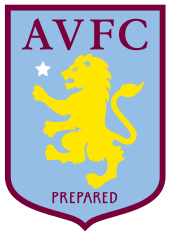
On 6 April 2016, the club confirmed that it would be using a new badge from the 2016–17 season after consulting fan groups for suggestions. The lion in the new badge has claws added to it, and the word "Prepared" was removed to increase the size of the lion and club initials in the badge.[8]
Kit sponsorship
Aston Villa's kit was manufactured by local manufacturers until 1974 when Umbro was the first kit manufacturer to have their logo on a Villa shirt. Since 1974 the team have had a variety of kit manufacturers and sponsors from local and national manufacturers and sponsors.[50] Aston Villa forwent commercial kit sponsorship for the 2008–09 and 2009–10 seasons; instead advertising the charity Acorns Children's Hospice, the first deal of its kind in Premier League history.[53] The partnership continued until 2010 when a commercial sponsor replaced Acorns, with the hospice becoming the club's Official Charity Partner.[54] In 2014–15, the Acorns name returned to Aston Villa's home and away shirts, but only for children's shirts re-affirming the club's support for the children's charity. A shirt sleeve sponsor was used for the first time in the 2019-20 season with BR88 being displayed.[55] The kit manufacturer for the 2020-21 season will Kappa with Cazoo as the shirt sponsor.[56]
Stadium
Aston Villa's current home venue is Villa Park; the team previously played at Aston Park (1874–1876) and Wellington Road (1876–1897). Villa Park is the largest football stadium in the English Midlands, and the eighth largest stadium in England. It has hosted 16 England internationals at senior level, the first in 1899, and the most recent in 2005. Thus, it was the first English ground to stage international football in three different centuries.[57] Villa Park is the most used stadium in FA Cup semi-final history, having hosted 55 semi-finals. The club have planning permission to extend the North Stand; this will involve the 'filling in' of the corners to either side of the North Stand. If completed, the capacity of Villa Park will be increased to approximately 51,000.
The current training ground is located at Bodymoor Heath near Kingsbury in north Warwickshire, the site for which was purchased by former chairman Doug Ellis in the early 1970s from a local farmer. Although Bodymoor Heath was state-of-the-art in the 1970s, by the late 1990s the facilities had started to look dated. In November 2005, Ellis and Aston Villa plc announced a state of the art GB£13 million redevelopment of Bodymoor in two phases. The new training ground was officially unveiled on 6 May 2007, by then manager Martin O'Neill, then team captain Gareth Barry and 1982 European Cup winning team captain Dennis Mortimer, with the Aston Villa squad moving in for the 2007–08 season.[58]
It was announced on 6 August 2014, that Villa Park would appear in the FIFA video game from FIFA 15 onwards, with all other Premier League stadiums also fully licensed from this game onwards.[59]
Ownership

The first shares in the club were issued towards the end of the 19th century as a result of legislation that was intended to codify the growing numbers of professional teams and players in the Association Football leagues. FA teams were required to distribute shares to investors as a way of facilitating trading among the teams without implicating the FA itself. This trading continued for much of the 20th century until Ellis started buying up many of the shares in the 1960s. He was chairman and substantial shareholder of "Aston Villa F.C." from 1968 to 1975 and the majority shareholder from 1982 to 2006. The club were floated on the London Stock Exchange (LSE) in 1996, and the share price fluctuated in the ten years after the flotation.[60] In 2006 it was announced that several consortia and individuals were considering bids for Aston Villa.[61]
On 14 August 2006, it was confirmed that Randy Lerner, then owner of the National Football League's Cleveland Browns, had reached an agreement of £62.6 million with Aston Villa for a takeover of the club. Lerner took full control on 18 September with Ellis and his board replaced with a new board by Lerner on 19 September 2006.[61] Lerner appointed himself Chairman of the club with Charles Krulak as a non-executive director and Ellis awarded the honorary position of Chairman Emeritus.[62] Lerner put the club up for sale in May 2014, valuing it at an estimated £200 million.[63]
On 18 May 2016, Randy Lerner agreed the sale of Aston Villa to Recon Group, owned by Chinese businessman Xia Jiantong. The sale was completed on 14 June 2016 for a reported £76 million after being approved by the Football League, with the club becoming part of Recon Group's Sport, Leisure and Tourism division.[64][65][66] Recon Group were selected to take over Aston Villa following a selection process by the club.[67][68]
After failing to secure promotion to the Premier League in the 2017–18 season speculation about financial difficulties at the club began to mount. This prompted the owner Tony Xia to seek additional investment. On 20 July 2018 it was announced that the NSWE group, an Egyptian company owned by the Egyptian billionaire Nassef Sawiris and the American billionaire Wes Edens were to invest in the football club. They purchased a controlling 55% stake in the club and Sawiris took over the role of club chairman.[69] On 9 August 2019, on the eve of Villa's Premier League return, documents from Companies House revealed that Recon Group's minority share ownership had been bought out, and Dr. Tony Xia no longer had any stake in the club.[48]
Social responsibility
Aston Villa have a unique relationship with the Acorns Children's Hospice charity that is groundbreaking in English football.[70] In a first for the Premier League, Aston Villa donated the front of the shirt on their kit, usually reserved for high-paying sponsorships, to Acorns Hospice so that the charity would gain significant additional visibility and greater fund raising capabilities.[71] Outside of the shirt sponsorship the club have paid for hospice care for the charity as well as regularly providing player visits to hospice locations.[72][73]
In September 2010, Aston Villa launched an initiative at Villa Park called Villa Midlands Food (VMF) where the club will spend two years training students with Aston Villa Hospitality and Events in association with Birmingham City Council. The club will open a restaurant in the Trinity Road Stand staffed with 12 students recruited from within a ten-mile (16 km) radius of Villa Park with the majority of the food served in the restaurant sourced locally.[74]
Supporters and rivalries
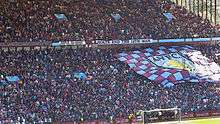
Aston Villa have a large fanbase and draw support from all over the Midlands and beyond, with supporters' clubs all across the world. Former Villa chief executive Richard Fitzgerald has stated that the ethnicity of the supporters is currently 98% white. When Randy Lerner's regime took over at Villa Park, they aimed to improve their support from ethnic minorities. A number of organisations have been set up to support the local community, including Aston Pride.[75] A Villa in the Community programme has also been set up to encourage support among young people in the region.[76] The new owners have also initiated several surveys aimed at gaining the opinions of Villa fans and to involve them in the decision making process. Meetings also occur every three months where supporters are invited by ballot and are invited to ask questions to the Board.[77] In 2011, the club supported a supporter-based initiative for an official anthem to boost the atmosphere at Villa Park. The song "The Bells Are Ringing" is to be played before games.[78]
Like many English football clubs, Aston Villa have had several hooligan firms associated with them: Villa Youth, Steamers, Villa Hardcore and the C-Crew, the last mentioned being very active during the 1970s and 1980s. As can be seen across the whole of English football, the hooligan groups have now been marginalised.[79] In 2004, several Villa firms were involved in a fight with QPR fans outside Villa Park in which a steward died.[80] The main groupings of supporters can now be found in a number of domestic and international supporters' clubs. This includes the Official Aston Villa Supporters Club which also has many smaller regional and international sections.[81] There were several independent supporters clubs during the reign of Doug Ellis but most of these disbanded after his retirement.[62] The supporter group My Old Man Said formed to stand up for Villa supporters' rights, as a direct result of Villa supporters' protest against the club's appointment of Alex McLeish. The club's supporters also publish fanzines such as Heroes and Villains and The Holy Trinity.
Aston Villa's arch-rivals are Birmingham City, with games between the two clubs known as the Second City Derby.[6] Historically though, West Bromwich Albion have arguably been Villa's greatest rivals, a view highlighted in a fan survey, conducted in 2003.[82] The two teams contested three FA Cup finals in the late 19th century. Villa also enjoy less heated local rivalries with Wolverhampton Wanderers and Coventry City. Through the relegation of West Brom and Birmingham City, to the Football League Championship, in the 2005–06 season, at the start of 2006–07 Premiership season, Villa were the only Midlands club in that League. The nearest opposing team Villa faced during that season was Sheffield United, who played 62 miles (100 km) away in South Yorkshire.[83] For the 2010–11 season, West Bromwich Albion were promoted and joined Aston Villa, Wolverhampton Wanderers, and Birmingham City in the Premier League. This marked the first time that the "West Midlands' Big Four" clubs have been in the Premier League at the same time, and the first time together in the top flight since the 1983–84 season. Birmingham were relegated at the end of the 2010–11 season, ending this period.[84]
Statistics
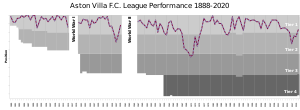
At the end of the 2019–20 season, Aston Villa had spent 106 seasons in the top tier of English football. The only club to have spent longer in the top flight are Everton, with 117 seasons,[85] making Aston Villa versus Everton the most-played fixture in English top-flight football. Aston Villa were relegated from the top tier of English football in 2016, having played in every Premier League season since its establishment in 1992–93, but were promoted back in 2018–19. They are ninth in the All-time FA Premier League table, and have the fifth highest total of major honours (20) won by an English club.[86]
Aston Villa currently hold the record number of league goals scored by any team in the English top flight; 128 goals were scored in the 1930–31 season, one more than Arsenal who won the league that season for the very first time, with Villa runners-up.[87] Villa forward Archie Hunter became the first player to score in every round of the FA Cup in Villa's victorious 1887 campaign. Villa's longest unbeaten home run in the FA Cup spanned 13 years and 19 games, from 1888 to 1901.[88]
Aston Villa are one of five English teams to have won the European Cup. They did so on 26 May 1982 in Rotterdam, beating Bayern Munich 1–0 thanks to Peter Withe's goal.[89]
Club honours
Aston Villa have won European and domestic league honours. The club's last English honour was in 1996 when they won the League Cup, and most recently they won the 2001 UEFA Intertoto Cup.
Domestic
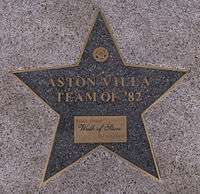
- League Titles
- Cups
- FA Cup: 7
- Winners: 1981
Players
First team squad
Note: Flags indicate national team as defined under FIFA eligibility rules. Players may hold more than one non-FIFA nationality.
|
|
Under 23s and Academy
Notable players

There have been many players who can be called notable throughout Aston Villa's history. These can be classified and recorded in several forms. The Halls of Fame and PFA Players of the Year are noted below. As of 2019, Aston Villa are only surpassed by Tottenham Hotspur (78), for providing the most England internationals with 74 Villa players debuting for England, this record is jointly held with Liverpool.[94][95] Aston Villa have had several players who were one-club men, including inaugural club Hall of Fame inductee Billy Walker. In 1998, to celebrate the 100th season of League football, The Football League released a list entitled the Football League 100 Legends that consisted of "100 legendary football players." There were seven players included on the list who had formerly played for Villa: Danny Blanchflower, Trevor Ford, Archie Hunter, Sam Hardy, Paul McGrath, Peter Schmeichel and Clem Stephenson.[96]
Three Aston Villa players have won the PFA Players' Player of the Year award. In 1977 Andy Gray won the award. In 1990 it was awarded to David Platt, whilst Paul McGrath won it in 1993. The PFA Young Player of the Year, which is awarded to players under the age of 23, has been awarded to four players from Aston Villa: Andy Gray in 1977; Gary Shaw in 1981; Ashley Young in 2009 and James Milner in 2010. The National Football Museum in Preston, Lancashire administers the English Football Hall of Fame which currently contains one Villa team, four Villa players and two managers. The 1982 team were inducted into the Hall of Fame in October 2011.[97] Joe Mercer was inducted into the Hall of Fame for his career as a manager including his time at Aston Villa.[98] Graham Taylor was elected to the Hall of Fame in 2010 as a Football Foundation Community Champion.[99] The only Villa players in the Hall of Fame are Clem Stephenson, Danny Blanchflower, Peter Schmeichel and Paul McGrath.
In 2006 the club announced the creation of an "Aston Villa Hall of Fame." This was voted for by fans and the inaugural induction saw 12 former players, managers and directors named.[11] Former club captain Stiliyan Petrov was added to the list in May 2013.[100]
Non-playing staff
Corporate hierarchy
- Source:[101]
| Position | Name |
|---|---|
| Executive Chairman | Nassef Sawiris |
| Co-Chairman | Wes Edens |
| Chief Executive Officer & Director | Christian Purslow[102] |
Management hierarchy
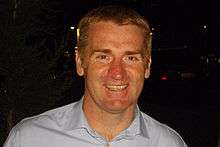
| Position | Name |
|---|---|
| Sporting Director | Johan Lange[103] |
| Head Coach | Dean Smith[4] |
| Assistant Head Coach | Richard O'Kelly[104] |
| Assistant Head Coach | John Terry[4] |
| Assistant Head Coach | Craig Shakespeare[105] |
| Goalkeeping Coach | Neil Cutler[106] |
| Head Physiotherapist | Alan Smith |
| Head Sports Scientist | Jack Sharkey[107] |
| Head Performance Analyst | David Stewart |
| Head of Performance Psychology | Tom Bates |
| Under-23 Manager | Mark Delaney |
| Under-18 Manager | Richard Beale |
| Under-18 Assistant Manager | George Boateng |
| Academy Manager | Mark Harrison[108] |
Notable managers
The following managers have all won at least one trophy when in charge or have been notable for Villa in the context of the League, for example Jozef Vengloš who holds a League record.
| Name | Period | Played | Win | Draw | Lose | Win%[D] | Honours | |
|---|---|---|---|---|---|---|---|---|
| From | To | |||||||
| George Ramsay | 1 August 1884 | 31 May 1926 | 1,327 | 658 | 414 | 255 | 49.59 | 6 FA Cups, 6 Division One championships. Also in 2006 was inducted into the Aston Villa Hall of Fame. |
| Jimmy Hogan | 1 November 1936 | 1 September 1939 | 124 | 57 | 26 | 41 | 45.97 | Division Two Champions |
| Eric Houghton | 1 September 1953 | 30 November 1958 | 250 | 88 | 65 | 97 | 35.20 | FA Cup winner. Also in 2006 was inducted into the Aston Villa Hall of Fame. |
| Joe Mercer | 1 December 1958 | 31 July 1964 | 282 | 120 | 63 | 99 | 42.55 | Division Two Champions, League Cup winner Inducted into the English Football Hall of Fame |
| Ron Saunders | 4 June 1974 | 9 February 1982 | 353 | 157 | 98 | 98 | 44.48 | 2 League Cups, Division One champions. Also in 2006 was inducted into the Aston Villa Hall of Fame. |
| Tony Barton | 9 February 1982 | 18 June 1984 | 130 | 58 | 24 | 48 | 44.62 | European Cup, European Super Cup |
| Jozef Vengloš | 22 July 1990 | 28 May 1991 | 49 | 16 | 15 | 18 | 32.65 | First manager not from Britain or Ireland to take charge of a top-flight club in England.[109] |
| Ron Atkinson | 7 July 1991 | 10 November 1994 | 178 | 77 | 45 | 56 | 43.26 | League Cup winner |
| Brian Little | 25 November 1994 | 24 February 1998 | 164 | 68 | 45 | 51 | 41.46 | League Cup winner. Also in 2006 was inducted into the Aston Villa Hall of Fame. |
| John Gregory | 25 February 1998 | 24 January 2002 | 190 | 82 | 52 | 56 | 43.16 | Intertoto Cup winner |
| Dean Smith | October 2018 | Present | 38 | 19 | 11 | 8 | 50.00 | 1 Championship Play-off Winners |
In popular culture
A number of television programmes have included references to Aston Villa over the past few decades. In the sitcom Porridge, the character Lennie Godber is a Villa supporter.[110] When filming began on Dad's Army, Villa fan Ian Lavender was allowed to choose Frank Pike's scarf from an array in the BBC wardrobe; he chose a claret and blue one – Aston Villa's colours.[111] The character Nessa in the BBC sitcom Gavin & Stacey was revealed as an Aston Villa fan in an episode screened in December 2009.[112]
In the 1952 film The Card, the main character Denry Machin becomes a town councillor and purchases the rights to locally born Aston Villa player 'Callear', the "greatest centre-forward in England", for the failing local football club. Villa have also featured on several occasions in prose. Stanley Woolley, a character in Derek Robinson's Booker shortlisted novel Goshawk Squadron is an Aston Villa fan and names a pre-war starting eleven Villa side. Together with The Oval, Villa Park is referenced by the poet Philip Larkin in his poem about the First World War, MCMXIV.[113] Aston Villa are also mentioned in Harold Pinter's play The Dumb Waiter.[114]
Aston Villa Women
Aston Villa have a women's football side that compete in the Women's Super League having been promoted as champions of the 2019-20 FA Women's Championship. They were founded as Solihull F.C. in 1973 and affiliated to Aston Villa in 1989.[115]
Footnotes
- A. ^ In 2001 Aston Villa were one of three co-winners of the Intertoto Cup with Paris Saint-Germain and Troyes AC. The club also won all of their 2008 Intertoto Cup rounds to be named joint-winners and progress to the UEFA Cup, the format was changed in 2006 to award the Intertoto Trophy to the side progressing furthest in the UEFA Cup, which was S.C. Braga.
- B. ^ Up until 1992, the top division of English football was the Football League First Division. The Premier League took over from the First Division as the top tier of the English football league system upon its formation in 1992. The First Division then became the second tier of English football, the Second Division became the third tier, and so on. The First Division is now known as the Football League Championship, while the Second Division is now known as Football League One.
- C ^ Saunders was never a player for Aston Villa; he was the manager from 1974 to 1982.
- D ^ Win% is rounded to two decimal places
References
Specific
- "Aston Villa Football Club information". BBC Sport. 1 January 2010. Archived from the original on 22 June 2007. Retrieved 26 June 2007.
- "Premier League Handbook 2019/20" (PDF). Premier League. p. 8. Archived (PDF) from the original on 27 July 2020. Retrieved 27 July 2020.
- "Aston Villa: Wes Edens & Nassef Sawiris to make 'significant investment' in club". BBC Sport. Retrieved 25 May 2019.
- "Dean Smith: Aston Villa appoint new head coach with John Terry as assistant". BBC Sport. 10 October 2018. Archived from the original on 10 October 2018. Retrieved 11 October 2018.
- Ward, Adam; Griffin, Jeremy; p. 161.
- Matthews, Tony (2000). "Aston Villa". The Encyclopedia of Birmingham City Football Club 1875–2000. Cradley Heath: Britespot. p. 17. ISBN 978-0-9539288-0-4.
- Woodhall, Dave (2007). The Aston Villa Miscellany. Vision Sports Publishing Ltd. p. 16. ISBN 978-1-905326-17-4.
- "Introducing our badge for 2016/17". Aston Villa Football Club. 6 April 2016. Archived from the original on 9 April 2016. Retrieved 6 April 2016.
- McCarthy, Nick (26 November 2007). "Cup presented to Aston Villa founder member Jack Hughes is back with his family". Birmingham Mail. Archived from the original on 25 January 2012. Retrieved 21 July 2009.
- Ward, Adam; Griffin, Jeremy; p. 6.
- "Aston Villa Hall of Fame". Aston Villa F.C. Archived from the original on 15 October 2007.
- Ward, Adam; Griffin, Jeremy; p. 192.
- Ward, Adam; Griffin, Jeremy; pp. 33–36.
- Hayes, Dean; p. 170.
- Ward, Adam; Griffin, Jeremy; p. 71.
- Ward, Adam; Griffin, Jeremy; p. 75.
- Ward, Adam; Griffin, Jeremy; pp. 86–87.
- Ward, Adam; Griffin, Jeremy; p. 93.
- Ward, Adam; Griffin, Jeremy; p. 100.
- Ward, Adam; Griffin, Jeremy; p. 106.
- Ward, Adam; Griffin, Jeremy; p. 111.
- Ward, Adam; Griffin, Jeremy; p. 148.
- Ward, Adam; Griffin, Jeremy; p. 155.
- "Aston Villa". Football Club History Database. Richard Rundle. Archived from the original on 29 December 2012. Retrieved 19 March 2012.
- "Chelsea claim FA Cup glory". BBC Sport. 20 May 2000. Archived from the original on 10 October 2012. Retrieved 21 September 2010.
- "O'Leary parts company with Villa". BBC Sport. 19 July 2006. Archived from the original on 11 October 2013. Retrieved 15 September 2008.
- "Lerner set to complete Villa deal". BBC Sport. 27 September 2006. Archived from the original on 30 March 2013. Retrieved 15 September 2008.
- "The Aston Villa Hit: The Current Crest". Aston Villa F.C. Archived from the original on 13 October 2010. Retrieved 19 March 2012.
- "Villa secure new kit deal with Nike". ESPNsoccernet. 7 February 2007. Archived from the original on 8 November 2012. Retrieved 15 September 2008.
- McNulty, Phil (28 February 2010). "Aston Villa 1–2 Man Utd". BBC Sport. Archived from the original on 16 April 2012. Retrieved 28 February 2010.
- "Club Statement: Martin O'Neill". Aston Villa F.C. 9 August 2010. Archived from the original on 17 August 2010. Retrieved 9 August 2010.
- "Aston Villa appoint Alex McLeish as manager". BBC Sport. 17 June 2011. Archived from the original on 17 June 2011. Retrieved 18 June 2011.
- "Alex McLeish sacked as Aston Villa manager". BBC Sport. BBC. 14 May 2012. Archived from the original on 14 May 2012. Retrieved 14 May 2012.
- "Aston Villa appoint Paul Lambert as new manager". BBC Sport. BBC. 2 July 2012. Archived from the original on 16 October 2013. Retrieved 29 December 2013.
- "Aston Villa announce £53.9m loss for 2010–11 financial year". BBC Sport. 28 February 2012. Archived from the original on 10 March 2012. Retrieved 19 March 2012.
- "Aston Villa: Owner Randy Lerner puts club up for sale". BBC Sport. 12 May 2014. Archived from the original on 1 June 2014. Retrieved 24 July 2014.
- "Aston Villa: Paul Lambert sacked as manager". BBC Sport. 11 February 2015. Archived from the original on 13 February 2015. Retrieved 11 February 2015.
- "Tim Sherwood appointed new Aston Villa boss". BBC Sport. 14 February 2015. Archived from the original on 2 January 2016. Retrieved 11 February 2018.
- Percy, John (25 October 2015). "Tim Sherwood sacked as Aston Villa owner Randy Lerner runs out of patience with beleagured [sic] manager". Telegraph.co.uk. Archived from the original on 28 October 2015. Retrieved 29 October 2015.
- Jennings, Patrick (16 April 2016). "Manchester United 1 – 0 Aston Villa". BBC Sport. BBC. Archived from the original on 17 April 2016. Retrieved 17 April 2016.
- "Aston Villa: Dr Tony Xia completes takeover of Championship club". BBC Sport. 14 June 2016. Archived from the original on 13 November 2016. Retrieved 13 November 2016.
- "Roberto di Matteo: Aston Villa sack manager 124 days after he takes charge". BBC. 3 October 2016. Archived from the original on 3 October 2016. Retrieved 4 October 2016.
- "Aston Villa: Steve Bruce appointed manager of Championship club". BBC Sport. 12 October 2016. Archived from the original on 29 October 2016. Retrieved 13 November 2016.
- "Steve Bruce: Aston Villa sack manager after one win in nine league games". BBC Sport. 3 October 2018. Archived from the original on 3 October 2018. Retrieved 2 November 2018.
- "Dean Smith: Aston Villa appoint new head coach with John Terry as assistant". BBC Sport. 10 October 2018. Archived from the original on 11 October 2018. Retrieved 2 November 2018.
- "John Terry appointed Aston Villa assistant as Smith named manager | Goal.com". Retrieved 2 November 2018.
- "Championship play-off final: Aston Villa 2-1 Derby County". 27 May 2019 – via www.bbc.co.uk.
- Maher, Matt (9 August 2019). "Tony Xia leaves Aston Villa with former owner's remaining shareholding wiped out". Express & Star.
- "Aston Villa staying up better than play-off win - Dean Smith". 26 July 2020 – via www.bbc.co.uk.
- "Aston Villa". Historical Football Kits. Archived from the original on 19 January 2013. Retrieved 19 March 2012.
- When Saturday Comes: The Half Decent Football Book; p. 183.
- Schwartz, Nick (26 May 2014). "Meet the 3 teams promoted to the Premier League". USA Today. Archived from the original on 28 May 2014. Retrieved 4 June 2014.
- Gardner, Alan (3 June 2008). "Aston Villa to promote charity in place of shirt sponsor". The Guardian. London. Archived from the original on 4 June 2008. Retrieved 3 June 2008.
- Griffin, Jon (16 July 2010). "Villa Sign Biggest Kit Deal in History". Birmingham Mail. Archived from the original on 27 September 2016. Retrieved 25 September 2016.
- "Aston Villa secure BR88 as first ever sleeve sponsor". Soccerex. 13 June 2019. Retrieved 5 August 2020.
- Dick, Brian (29 June 2020). "Confirmed: Aston Villa make huge sponsorship announcement". Birmingham Mail. Retrieved 5 August 2020.
- Lockley, Mike (7 June 2014). "When the world came to Villa Park..." Birmingham Mail. Archived from the original on 27 September 2016. Retrieved 25 September 2016.
- "Gaffer on BMH". Aston Villa F.C. Archived from the original on 25 August 2007.
- "Villa Park to make debut in EA SPORTS FIFA 15 game – Latest News – Aston Villa". avfc.co.uk. Archived from the original on 10 August 2014.
- "Company Histories & Profiles: Aston Villa plc". FundingUniverse.com. Archived from the original on 4 March 2012. Retrieved 20 March 2012.
- Austin, Simon (19 September 2006). "End of Ellis era". BBC Sport. Archived from the original on 16 January 2009. Retrieved 15 September 2008.
- Conn, David (23 August 2006). "Ellis rolls away from his nice Villa earner". The Guardian. London. Archived from the original on 4 December 2013. Retrieved 19 March 2012.
- Percy, John (20 April 2014). "Randy Lerner ready to sell as Aston Villa limp to Premier League safety". Telegraph.co.uk. Archived from the original on 24 March 2017. Retrieved 3 April 2018.
- "Club statement: Sale confirmed | Latest News | Aston Villa". www.avfc.co.uk. Archived from the original on 15 June 2016. Retrieved 14 June 2016.
- Murphy, Pat (14 June 2016). "Aston Villa: Dr Tony Xia completes takeover of Championship club". Archived from the original on 14 June 2016. Retrieved 14 June 2016.
- "Introducing Tony Xia | Latest News | Aston Villa". www.avfc.co.uk. Archived from the original on 19 May 2016. Retrieved 20 May 2016.
- "Aston Villa owner Dr Tony Xia to give new boss 'up to £50m' to spend". 19 May 2016. Archived from the original on 20 May 2016. Retrieved 20 May 2016.
- "Aston Villa takeover: Chinese businessman Dr Tony Xia agrees £60m deal". 18 May 2016. Archived from the original on 19 May 2016. Retrieved 19 May 2016.
- Official, AVFC (20 July 2018). "Club statement: Investment in Aston Villa". Aston Villa F.C. Retrieved 20 July 2018.
- Gardner, Alan (3 June 2008). "Aston Villa to promote charity in place of shirt sponsor". The Guardian. London. Archived from the original on 4 June 2008. Retrieved 11 December 2016.
- Lansley, Peter (4 June 2008). "Aston Villa's bold initiative boosts charity" (reprint hosted at NewsBank). The Sunday Times. London. Retrieved 6 September 2010.
- Kendrick, Mathew (23 December 2009). "Aston Villa stars visit Acorns Hospice in Walsall". Birmingham Mail. Archived from the original on 20 October 2012. Retrieved 19 March 2012.
- "Aston Villa & Acorns in partnership". Acorns Children's Hospice. Archived from the original on 30 April 2013. Retrieved 31 May 2013.
- Kendrick, Mathew (20 September 2010). "Aston Villa's new restaurant hopes to serve up hospitality success to disaffected youngsters". Birmingham Mail. Archived from the original on 17 September 2011. Retrieved 11 November 2010.
- "Richard FitzGerald: Bright Future". Aston Villa Supporters' Trust. 10 April 2007. Archived from the original on 29 September 2007.
- "Villa in the Community". Aston Villa F.C. Archived from the original on 27 September 2006. Retrieved 15 September 2008.
- "Aston Villa Supporters Survey Website". Aston Villa F.C. Archived from the original on 22 May 2013. Retrieved 15 September 2008.
- "Check out new version of classic 'Bells Are Ringing' anthem". Aston Villa F.C. 8 April 2011. Archived from the original on 26 August 2011. Retrieved 31 May 2013.
- Brown, Danny; Brittle, Milo; p. 1.
- Wells, Tom (19 December 2004). "Death of a Steward ... what 'really' happened". Sunday Mercury. Archived from the original on 21 September 2011. Retrieved 19 March 2012.
- "Lions Club Directory". Aston Villa F.C. Archived from the original on 21 June 2012. Retrieved 19 March 2012.
- "Club rivalries uncovered" (PDF). The Football Fans Census. Archived from the original (PDF) on 10 September 2008. Retrieved 15 September 2008.
- Gordos, Phil (8 May 2006). "Is West Midlands Football in decline?". BBC Sport. Archived from the original on 2 January 2007. Retrieved 15 September 2008.
- Dawkes, Phil (22 May 2011). "Tottenham 2–1 Birmingham". BBC Sport. Archived from the original on 9 April 2012. Retrieved 19 March 2012.
- Pietarinen, Heikki (1 November 2014). "England – First Level All-Time Tables 1888/89–2011/12". Rec.Sport.Soccer Statistics Federation. Archived from the original on 24 August 2017. Retrieved 1 November 2014.
- "All-time English Honours Table". KryssTal. Archived from the original on 15 August 2012. Retrieved 19 March 2012.
- "League Records: Goals". The Football League. Archived from the original on 20 March 2012. Retrieved 19 March 2012.
- Goodyear, David; Matthews, Tony; p. 168.
- Ward, Adam; Griffin, Jeremy; pp. 130–135.
- Up until 1992, the top division of English football was the Football League First Division; since then, it has been the FA Premier League. At the same time, the Second Division was renamed the First Division, and the Third Division was renamed the Second Division.
- "Report: Championship Play-Off Final".
- "First Team". avfc.co.uk. Archived from the original on 7 August 2018. Retrieved 20 September 2018.
- "Aston Villa squad numbers 2019/20 announced". avfc.co.uk. Retrieved 11 August 2019.
- Bevan, Chris. "Three Lions: One World Cup, 147 years and 1,000 games - the numbers behind England men's milestone". BBC Sport. Retrieved 4 January 2020.
- Sport, Telegraph (April 2015). "How many players has your club provided for England?". Telegraph. Archived from the original on 1 April 2015. Retrieved 1 April 2015.
- "Sport: Football Legends list in full". BBC News. 5 August 1998. Archived from the original on 12 January 2016. Retrieved 19 March 2012.
- "ASTON VILLA'S EUROPEAN CUP WINNERS JOIN HALL OF FAME". Football Hall of Fame. Archived from the original on 28 September 2018. Retrieved 28 September 2018.
- "Latest news – Hall of Fame 2009". National Football Museum. Archived from the original on 13 July 2009. Retrieved 8 July 2009.
- "Football honours Graham Taylor". Football Foundation. 5 October 2010.
- "Sport: Popular Petrov to be added to Iconic Villa Hall of Fame". Aston Villa F.C. 10 May 2013. Archived from the original on 23 September 2015. Retrieved 10 May 2013.
- "Who's who". Aston Villa F.C. Archived from the original on 15 July 2017. Retrieved 11 October 2018.
- "Christian Purslow: Aston Villa appoint ex-Liverpool MD as chief executive". BBC Sport. Retrieved 4 October 2018.
- McNulty, Phil (30 July 2020). "Aston Villa appoint Johan Lange as new sporting director". BBC Sport. Retrieved 30 July 2020.
- "Aston Villa appoint Richard O'Kelly as assistant head coach from Brentford". Sky Sports News. 15 October 2018. Archived from the original on 15 October 2018. Retrieved 15 October 2018.
- "Craig Shakespeare named Aston Villa assistant head coach". BBC Sport. 7 August 2020. Retrieved 7 August 2020.
- "Goalkeeper coach Neil Cutler leaves West Brom for Aston Villa". Express and Star. 2 November 2018. Archived from the original on 3 November 2018. Retrieved 2 November 2018.
- Preece, Ashley (13 September 2019). "Dean Smith's 18-man support team and their role at the club". birminghammail. Retrieved 30 September 2019.
- "New Academy Manager appointed". www.avfc.co.uk. Retrieved 30 September 2019.
- "Venglos first foreign coach". BBC Sport. 17 July 1998. Archived from the original on 15 January 2009. Retrieved 15 September 2008.
- Whitehead, Richard (1 September 2008). "The soul of Aston Villa in 50 moments, page 2". The Times. London. Archived from the original on 18 September 2008. Retrieved 15 September 2008.
- Whitehead, Richard (1 September 2008). "The soul of Aston Villa in 50 moments, page 9". The Times. London. Archived from the original on 18 September 2008. Retrieved 15 September 2008.
- "Stud Marks: We won't lie to you, another famous fan signs up for Aston Villa". Birmingham Mail. 14 December 2009. Archived from the original on 20 December 2009. Retrieved 20 March 2012.
- As if they were stretched outside The Oval or Villa Park, Philip Larkin, MCMXIV.
- Fisher, Philip (2007). "The Dumb Waiter at Trafalgar Studios 1". The British Theatre Guide. Archived from the original on 19 October 2013. Retrieved 20 March 2012.
- "Introducing Aston Villa Ladies". FA WSL. The Football Association. Archived from the original on 19 December 2018. Retrieved 5 July 2019.
Works cited
- Brown, Danny; Milo Brittle (2006). Villains: The Inside Story of Aston Villa's Hooligan Gangs. Milo Books. ISBN 978-1-903854-59-4.
- Goodyear, David; Matthews, Tony (1988). Aston Villa—A Complete Record 1874–1988. Breedon Books. ISBN 0-907969-37-2.
- Hayes, Dean (1997). The Villa Park Encyclopedia: A-Z of Aston Villa. Mainstream Publishing (2 October 1997). ISBN 978-1-85158-959-3.
- Ward, Adam; Griffin, Jeremy. The essential history of Aston Villa. Headline book publishing (2002). ISBN 0-7553-1140-X.
- When Saturday Comes: The Half Decent Football Book. Penguin UK. 2006. ISBN 978-0-14-192703-9.
External links

- Official website

- Aston Villa News – Sky Sports
- Aston Villa F.C. on BBC Sport: Club news – Recent results and fixtures
- Aston Villa F.C. companies grouped at OpenCorporates
- Aston Villa results and records at statto.com
